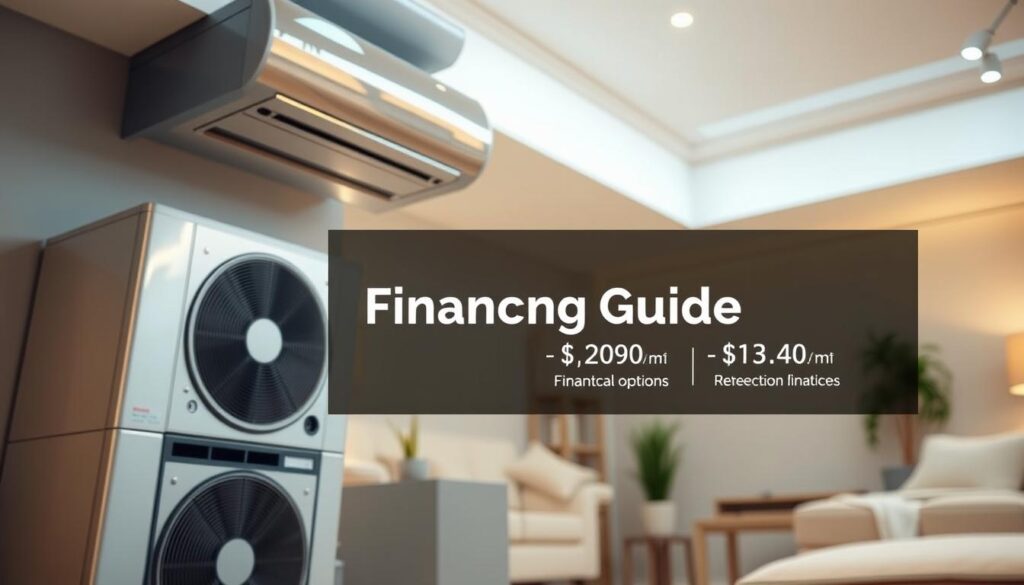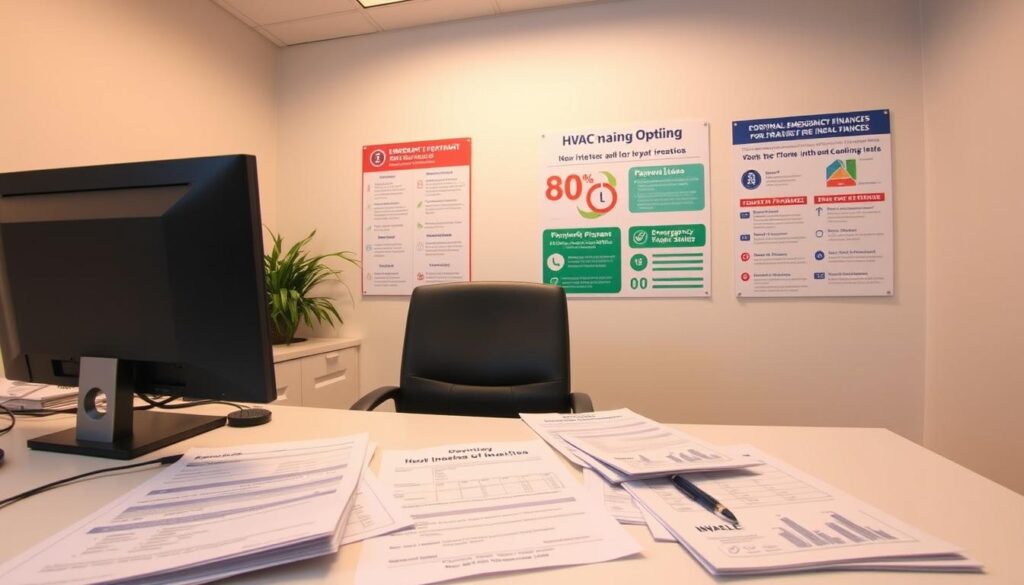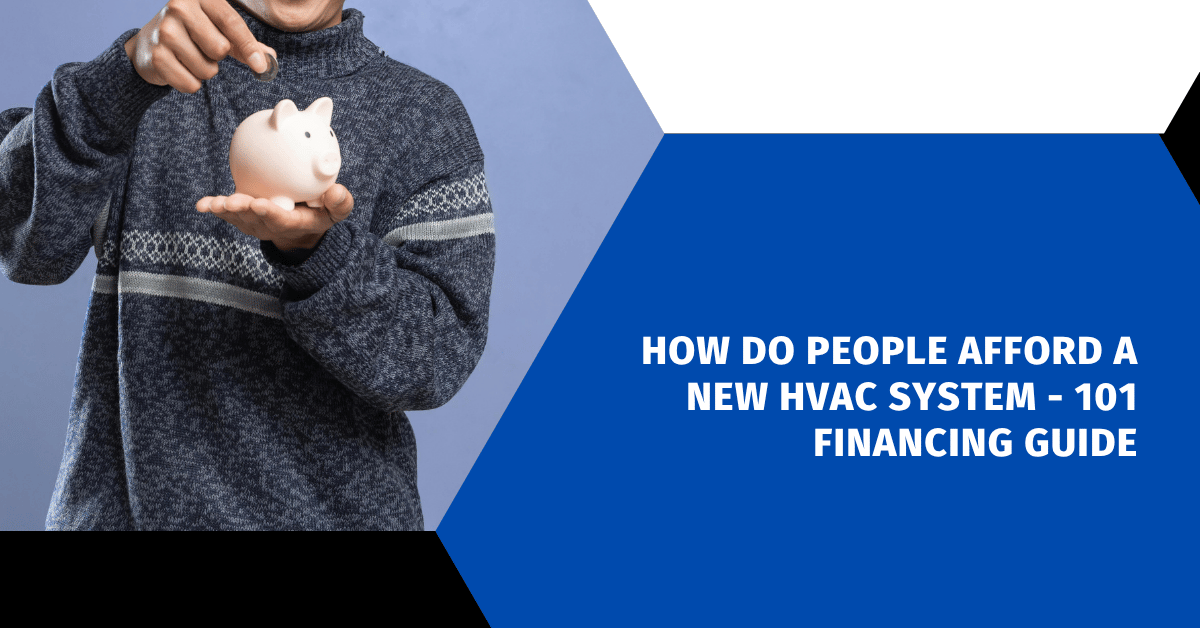Affiliate Disclosure
HVAC Guide Guys is a participant in the Amazon Services LLC Associates Program, an affiliate advertising program designed to provide a means for sites to earn advertising fees by advertising and linking to Amazon.
How Do People Afford a New HVAC System? Have you ever thought about how homeowners replace their HVAC systems without spending a lot? Most people can’t pay cash for a new heating and cooling system.

HVAC financing options are a big help for many homeowners. With costs between $5,000 and $12,500, finding the right way to pay is key. It keeps your home comfortable and efficient.
Learning how to afford a new HVAC system can prevent uncomfortable temperatures and damage. This guide will show you different ways to make your HVAC replacement affordable.
Key Takeaways
- HVAC system replacements typically cost between $5,000 and $12,500
- Multiple financing options exist for homeowners
- Interest rates for HVAC loans range from 13.5% to 19.5%
- Some financing options require no down payment
- Government and manufacturer programs can help reduce costs
Table of Contents
Understanding the True Cost of HVAC System Replacement
When you’re thinking about replacing your HVAC system, it’s important to know all the costs involved. The cost isn’t just the price of the system. It includes many other factors that affect the total cost.
Factors Affecting HVAC Installation Costs
Several key elements impact your hvac installation costs, including:
- Home size and square footage
- System efficiency ratings
- Local climate conditions
- Complexity of installation
- Existing ductwork condition
Average Price Ranges for Different System Types
| HVAC System Type | Cost Range | Average Installation |
|---|---|---|
| Central Air Conditioning | $5,800 – $14,000 | $9,900 |
| Gas Furnace | $3,200 – $9,500 | $6,350 |
| Heat Pump | $5,800 – $12,800 | $9,300 |
Additional Installation Expenses to Consider
There are also extra costs to think about, such as:
- Ductwork modifications
- Electrical upgrades
- Permit fees
- Removal of old equipment
“Proper installation is key to maximizing your HVAC system’s efficiency and longevity.”
Remember, investing in a high-quality installation can save you money in the long run. A professional will make sure your new system fits your home perfectly. This ensures it works well and uses less energy.
How Do People Afford a New HVAC System
Replacing an HVAC system can be a big financial challenge. Costs range from $5,000 to $12,000. Finding affordable financing is key to keeping your home comfortable and energy-efficient.
“Investing in a new HVAC system is not just an expense, but a long-term investment in your home’s comfort and energy savings.”
Fortunately, there are many ways to make a new HVAC system affordable:
- Manufacturer Financing Programs
- Personal Loans
- Credit Card Options
- Home Equity Loans
- Energy Rebate Programs
Exploring different financing options is the first step. Energy-efficient systems can save you money on utilities. Local companies like Duke Energy offer rebates up to $450 for new systems, helping with costs.
Timing your purchase is also important. The best times are March-May for air conditioning and late September-November for heating. You’ll find better prices and financing deals during these months.
Pro Tip: Always get multiple estimates and ask about financing promotions. This way, you’ll find the best deal for your home.
The right financing can make a big expense more manageable. It’s an investment in your home’s comfort and efficiency.
Explore Our HVAC Shop
Looking for top-rated HVAC tools, parts, and accessories? Visit our shop and find the perfect solution for your needs.
Visit the ShopExploring Available HVAC Financing Options
Upgrading your HVAC system doesn’t have to empty your wallet. There are many hvac financing options to help homeowners. These options make it easier to invest in home comfort and energy efficiency.
Looking into hvac payment plans, you’ll find several ways to fund your new system:
Personal Loans and Credit Options
Personal loans are a flexible way to finance HVAC upgrades. They come with:
- Interest rates from 6% to 36%
- Repayment terms of 36 to 60 months
- Quick funding, often in a week
- Minimal paperwork needed
Home Equity Financing Strategies
Homeowners can use their property’s value in two main ways:
- Home Equity Loans: Fixed rates with longer repayment times
- Home Equity Lines of Credit (HELOCs): Flexible borrowing with variable rates
Manufacturer Financing Programs
Many HVAC manufacturers offer special financing options. These options have unique benefits:
- Zero or low-interest intro periods
- Online application processes
- Quick approval times
- Potential rebates for specific equipment
“The right financing can turn an expensive upgrade into a manageable investment in home comfort.”
Your credit score greatly affects the rates you can get. About 70% of homeowners look into financing for HVAC replacements. This shows the need for flexible payment options.
Federal Tax Credits and Energy Efficiency Rebates
Upgrading to energy efficient hvac systems can save you a lot of money. The government offers big financial incentives. These incentives encourage homeowners to choose greener heating and cooling options.
The current federal tax credits for hvac rebates and tax credits are a big deal. Homeowners can get tax credits up to 30% of the installation costs. There are specific caps for different systems:
- Air-source Heat Pumps: Up to $2,000 credit
- Central Air Conditioners: Up to $600 credit
- Boilers: Up to $600 credit
- Biomass Fuel Stoves: Up to $2,000 credit
To get these tax credits, your new HVAC system must meet certain standards:
| System Type | Minimum Rating Requirements |
|---|---|
| Heat Pumps | SEER2: 16+, EER2: 12+, HSPF2: 9+ |
| Gas Boilers | AFUE: 95% or higher |
These hvac rebates and tax credits are available from January 1, 2023, to December 31, 2032. Remember, the credit percentages will decrease after 2032: dropping to 26% in 2033 and 22% in 2034.
“Investing in energy efficient hvac systems not only reduces your carbon footprint but also provides significant financial benefits through tax credits and possible energy savings.” – Energy Efficiency Expert
Pro tip: Check with local utility companies for more state-specific rebates. These can help lower your HVAC costs even more.
Special HVAC Financing Programs for Low Credit Scores
Having low credit doesn’t mean you can’t get a new HVAC system. Many homeowners find it hard to get financing, but there are special programs to help. These programs let you upgrade your home’s comfort.
It can be tough to find ways to afford a new HVAC system with bad credit. But, there are alternative financing options. They help you get past credit issues.
Alternative Financing Solutions
- Rent-to-Own Programs: Flexible options for those with challenging credit histories
- Secured loan opportunities with lower credit requirements
- HVAC company-specific payment plans
Requirements and Qualifications
Most alternative financing programs have specific qualifications. They help you get your new HVAC system:
| Qualification | Typical Requirements |
|---|---|
| Employment | Minimum 6 months of steady employment |
| Bank Account | Active checking account with no recent NSF incidents |
| Income Verification | Proof of stable income |
“Credit challenges don’t have to prevent you from maintaining a comfortable home environment.”
Key financing insights for low credit scores include:
- Instant approvals available for up to $12,000
- Monthly payments starting as low as $99
- Lease terms ranging from 12 to 96 months
- Options for early purchase savings
While most financing options need a credit score of 600 or higher, special programs look at more than just credit. Some lenders approve customers with poor or no credit history. This gives hope to those who can’t find traditional financing.
Explore Our HVAC Shop
Looking for top-rated HVAC tools, parts, and accessories? Visit our shop and find the perfect solution for your needs.
Visit the ShopGovernment Assistance Programs for HVAC Replacement

Finding ways to afford a new HVAC system can be tough for low-income families. Luckily, there are government programs that offer help with heating and cooling costs.
The Low-Income Home Energy Assistance Program (LIHEAP) is a big help for homeowners. It provides financial aid to manage energy bills.
“Assistance is available for those who know where to look” – U.S. Department of Energy
Here are some key programs to help you get a new HVAC system:
- Weatherization Assistance Program (WAP)
- LIHEAP Cooling Assistance
- State-specific Energy Assistance Programs
- Community Support Initiatives
The Weatherization Assistance Program (WAP) is very useful. This program helps low-income families by:
- Improving home energy efficiency
- Fixing energy systems for free
- Replacing units in some cases
- Lowering energy costs
States also offer extra help. Some give free fans or air conditioners to seniors and people with disabilities.
To find out about hvac rebates and tax credits, check out BenefitsCheckUp.org. This free tool helps you find programs that fit your needs.
An estimated 14 million U.S. households lack air conditioning, making these programs key for comfort and health.
Home Insurance and Warranty Coverage Options
Dealing with hvac system costs can be tough for homeowners. Knowing how home insurance and warranties can help with HVAC replacements is key. It can offer big financial relief when your system fails unexpectedly.
Home insurance and warranties protect your heating and cooling systems in different ways. Knowing what your policy covers is important. It helps you figure out how to afford a new HVAC system without spending too much.
Understanding Policy Coverage
Homeowners insurance usually covers HVAC systems in certain situations:
- Sudden accidental damage
- Damage from natural disasters
- Lightning strikes
- Hail storms
But, standard policies do not cover:
- Normal wear and tear
- Lack of maintenance
- Manufacturer defects
Filing Claims for HVAC Replacement
“Understanding your policy details can save you thousands in unexpected repair costs.”
Here’s what to do when you need an HVAC replacement:
- Review your current insurance policy
- Check covered perils
- Evaluate repair costs against deductible
- Consult with your insurance agent
| Coverage Type | Typical Cost | Potential Savings |
|---|---|---|
| Home Insurance | Varies by policy | Up to full system replacement |
| Home Warranty | $300-$600 annually | Partial system coverage |
| Manufacturer Warranty | Included with purchase | 5-10 year component protection |
Regular maintenance and knowing your coverage can lower hvac system costs. It helps you plan for replacements better.
Evaluating HVAC Company Payment Plans
Looking into hvac payment plans can save you a lot of money. Many HVAC companies offer special financing options. These make it easier for homeowners to replace their systems.
Each financing option has its own benefits. Here are some things to consider:
- Interest rates range from 0% to 20%
- Flexible repayment terms
- Potential promotional periods
- Credit score requirements
“Choosing the right HVAC financing can transform an expensive replacement into a manageable investment.”
Contractors often have several hvac payment plans. These can be better than bank loans. For example, some offer:
| Financing Type | Interest Rate | Typical Term |
|---|---|---|
| Zero-Interest Promotions | 0% | 12-18 months |
| Standard Financing | 5-15% | 3-7 years |
| Extended Payment Plans | 10-20% | Up to 10 years |
Pro tip: Always read the fine print and compare multiple hvac financing options before committing to a payment plan. Some contractors work with financial institutions. This can give you better rates and save you thousands over time.
Your credit score, income, and current finances affect your financing options. It’s important to look at each option carefully. This way, you can choose the best plan for your budget and future goals.
Explore Our HVAC Shop
Looking for top-rated HVAC tools, parts, and accessories? Visit our shop and find the perfect solution for your needs.
Visit the ShopEmergency HVAC Replacement Financing Solutions
When your HVAC system fails suddenly, finding quick financing is key. Homeowners need fast solutions to get back to comfort and safety. Knowing about hvac financing options can really help in emergencies.

Urgent HVAC replacement needs smart financial planning. The cost of new systems is $3,000 to $10,000. This makes quick financing essential for many families.
Quick Approval Financing Strategies
There are several ways to get a new HVAC system fast:
- Online lender personal loans with 24-hour approvals
- Credit card promotional financing
- HVAC manufacturer direct financing programs
- Peer-to-peer lending platforms
Short-term Financing Alternatives
| Financing Option | Approval Time | Interest Rate |
|---|---|---|
| Personal Loans | 24-48 hours | 6.99% – 35.99% |
| Credit Cards | Instant | 16% – 24% |
| HVAC Company Financing | Minutes | 0% – 17.99% |
Looking into how to afford a new hvac system in emergencies? Check out these quick financing options. Look at interest rates and repayment terms to find the best fit for your budget.
“Speed and affordability are key when replacing a failed HVAC system” – HVAC Financial Experts
Always look at the total cost of financing. This includes any fees and long-term interest. Some options might seem quick but could cost more in the long run.
Long-term Cost Benefits of Financing a New System
Getting an energy efficient hvac system might cost a lot at first. But, the long-term savings can be huge. When you look at the savings, getting a new system is a smart money move.
“A smart HVAC investment today can lead to significant savings tomorrow.”
Today’s HVAC systems are super efficient. They cut down your monthly bills a lot. Here are the main money-saving points:
- Reduced Energy Consumption: New systems use 20-30% less energy than old ones
- Lower Maintenance Costs: New tech means fewer repairs
- Potential Home Value Increase: Energy-efficient systems can make your home worth more
Now, let’s see how much you can save with a comparison:
| HVAC System Type | Initial Cost | Annual Energy Savings | Estimated Payback Period |
|---|---|---|---|
| Standard Efficiency System | $6,000 | $300 | 20 years |
| High-Efficiency System | $8,000 | $900 | 8-10 years |
Choosing an energy-efficient system can save you money over time. You’ll save on utility bills and maintenance. The trick is to pick a system that fits your home and financial plans.
Explore Our HVAC Shop
Looking for top-rated HVAC tools, parts, and accessories? Visit our shop and find the perfect solution for your needs.
Visit the ShopTips for Securing the Best HVAC Financing Rates
Finding the right hvac financing can be tough. But knowing how to get the best rates makes it easier. Your credit score is key to getting good interest rates and terms.
To get the best financing, follow these tips:
- Check and improve your credit score before applying
- Compare multiple financing offers
- Understand the total cost of financing
- Look beyond interest rates
Pro tip: A credit score of 690 or higher can significantly improve your financing terms.
| Lender | APR Range | Loan Amount | Minimum Credit Score |
|---|---|---|---|
| Discover | 7.99% – 24.99% | $2,500 – $40,000 | 660 |
| LightStream | 6.99% – 25.29% | $5,000 – $100,000 | 660 |
| Upgrade | 9.99% – 35.99% | $1,000 – $50,000 | 580 |
“The right financing can turn an expensive HVAC replacement into a manageable investment.” – HVAC Financial Expert
When looking at how to afford a new hvac system, keep these points in mind:
- Negotiate with lenders
- Look at manufacturer financing programs
- Check for tax credits and rebates
- Think about long-term costs
By researching and comparing hvac financing, you can find a plan that works for you. This way, you can stay comfortable at home without financial worry.
Conclusion
Figuring out how to afford a new HVAC system takes careful planning. You need to look at different financing options and think about the long-term costs. It’s important to find a balance between what you can afford now and saving money in the future.
Keeping your HVAC system in good shape is key. Most systems last 15 to 25 years. Regular maintenance can help your system work better for longer. When looking at financing, do your homework. 81 percent of people trusted their contractor’s advice when buying.
Your aim is to get a system that’s comfortable, saves energy, and is cost-effective. Look into financing programs, tax credits, and energy-saving options. This way, you can find a solution that fits your budget and keeps your home comfortable. The right choice can turn a big expense into a wise investment in your home’s future.

